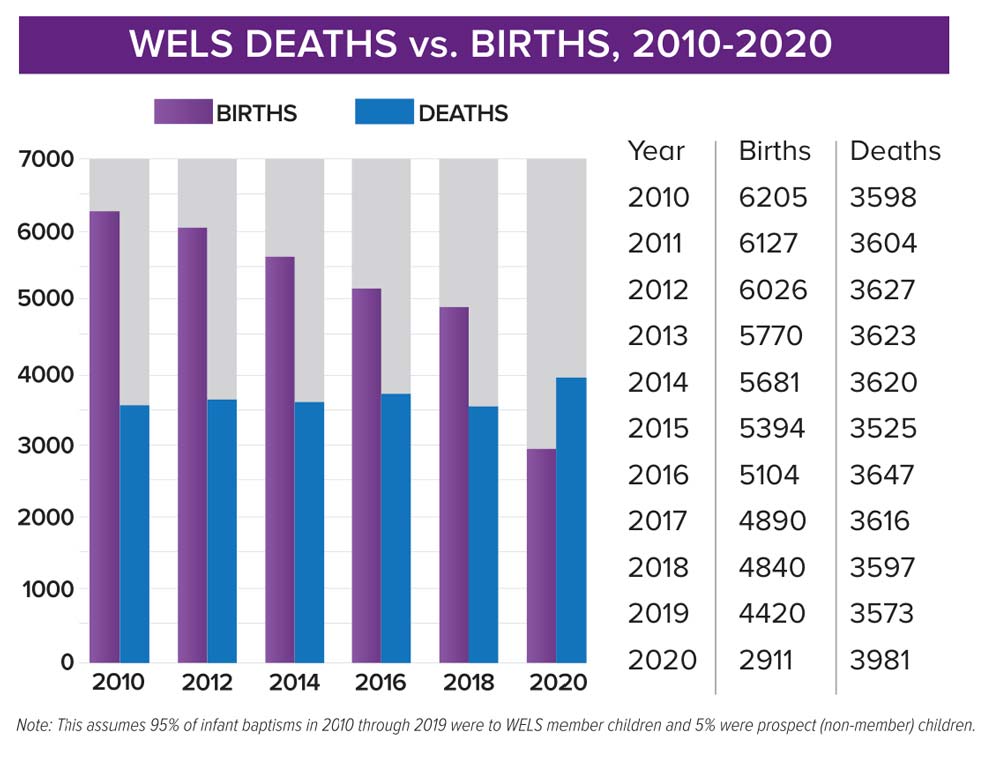 |
For about seven decades, at the end of each year, WELS has asked congregations to supply church statistics. Generally, over 95 percent of congregations do just that. A compliance rate that high yields very reliable and significant data. That data has been published each year in the WELS Statistical Report—over a hundred pages of numbers: membership, worship attendance, ministrations, and more.
This year, WELS Congregational Services published a statistical summary report that analyzes the data from 2020 and previous years. It translates those hundreds of pages of numbers into information that can be used by congregations and the synod as we plan how to best steward the resources God provides as we seek to do all we can with the gospel.
For example, the 2020 statistical summary demonstrates that for a decade, the birth rate in WELS has gone down every year. Simultaneously, the number of WELS members dying annually has been slowly trending up. Ten years ago, WELS had approximately 2,700 more births than deaths. In 2020, WELS had over one thousand more deaths than births. These are consistent, decade-long trends. If the trends hold, it will rapidly accelerate the statistical decline of WELS. Within a decade, it will mean substantially fewer elementary school-aged WELS members. This information will help shape our plans for the future.
Another example is the increase in church closures. Over the past half century, typically WELS would add congregations each year. Yet, 2020 marked the third year in a row that WELS ended the year with fewer congregations than the previous one, with ten congregations closing. When you look at the increase over the past decade in the number of churches worshiping fewer than 40 people per week, it seems very possible this trend in church closures will continue. That information helps us evaluate and prioritize plans, like the Board for Home Missions’ desire to open one hundred new missions in ten years.
 The statistical summary doesn’t only give us information that helps us with our planning; it also gives us reason to rejoice. For example, the 2020 summary makes it clear the Lord of the church held his providential hand over WELS during the pandemic. By God’s grace, WELS congregations weathered COVID-19 much better than most other church bodies. We see the power of the gospel in the fact that, in a year where most Americans stayed away from large gatherings and worship-visitor follow up was challenging, WELS still had almost 2,500 adult confirmations. We thank Christ for his goodness!
The statistical summary doesn’t only give us information that helps us with our planning; it also gives us reason to rejoice. For example, the 2020 summary makes it clear the Lord of the church held his providential hand over WELS during the pandemic. By God’s grace, WELS congregations weathered COVID-19 much better than most other church bodies. We see the power of the gospel in the fact that, in a year where most Americans stayed away from large gatherings and worship-visitor follow up was challenging, WELS still had almost 2,500 adult confirmations. We thank Christ for his goodness!
Rather than me providing more examples, why not take a look for yourself? You can find the WELS 2020 statistical summary at welscongregationalservices.net/stat-summary-2020. That summary also contains a devotional preface that discusses how to view statistics.
It is impossible to practice faithful stewardship without looking at all the information that is before us, including statistical information. However, when using statistics, it is also easy to conflate our responsibility and the Spirit’s work. It is our God-given responsibility to use God’s gift of reason to plan to do all we can with the gospel. It is the Spirit’s work to accomplish whatever he wants with that gospel proclamation. It is our job to plant the seed, to drive it home, to water it. But only the Spirit can make it grow. It is our job to carry out ministry. It is our job to assess if we are doing that wisely and well. It is always and only the Spirit’s job to increase our numbers, if he so wills. May God grant us the faith and the wisdom to use statistics wisely!
Learn more about WELS statistics at welscongregationalservices.net/stats.
Author: Jonathan Hein,
Volume 108, Number 10
Issue: October 2021







